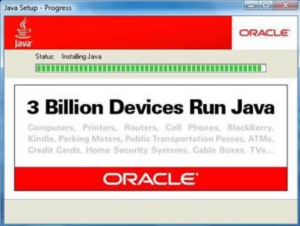If your computer is running Java and you have not updated to the latest version, you may be asking for trouble: A powerful exploit that takes advantage of a newly-disclosed security hole in Java has been rolled into automated exploit kits and is rapidly increasing the success rates of these tools in attacking vulnerable Internet users.
The exploit targets a bug in Java (CVE-20120-0507) that effectively allows the bypassing of Java’s sandbox, a mechanism built into the ubiquitous software that is designed partly to blunt attacks from malicious code. Microsoft’s Malware Protection Center warned last week that new malware samples were surfacing which proved highly effective at exploiting the flaw. Microsoft says the samples it saw loaded the ZeuS Trojan, but thieves can use such attacks to install malware of their choosing.
According to posts on several underground carding forums, the exploit has now been automatically rolled out to miscreants armed with BlackHole, by far the most widely used exploit pack. An exploit pack is a software toolkit that gets injected into hacked or malicious sites, allowing the attacker to foist a kitchen sink full of browser exploits on visitors. Those visiting such sites with outdated browser plugins may have malware silently installed, and Java is almost universally the most successful method of compromise across all exploit kits.
 According to software giant Oracle, Java is deployed across more than 3 billion systems worldwide. But the truth is that many people who have this powerful program installed simply do not need it, or only need it for very specific uses. I’ve repeatedly encouraged readers to uninstall this program, not only because of the constant updating it requires, but also because there seem to be a never-ending supply of new exploits available for recently-patched or undocumented vulnerabilities in the program.
According to software giant Oracle, Java is deployed across more than 3 billion systems worldwide. But the truth is that many people who have this powerful program installed simply do not need it, or only need it for very specific uses. I’ve repeatedly encouraged readers to uninstall this program, not only because of the constant updating it requires, but also because there seem to be a never-ending supply of new exploits available for recently-patched or undocumented vulnerabilities in the program.Case in point: On at least two Underweb forums where I regularly lurk, there are discussions among several core members about the sale and availability of an exploit for an as-yet unpatched critical flaw in Java. I have not seen firsthand evidence that proves this 0day exploit exists, but it appears that money is changing hands for said code.
If you do not need Java, junk it; you can always re-install it later if you need to. If you need Java for a specific Web site, I would suggest a two-browser approach. If you normally browse the Web with Firefox, for example, consider disabling the Java plugin in Firefox (from the Add-ons menu, click Plugins and then disable anything Java related, and restart the browser), and then using an alternative browser (Chrome, IE9, Safari, etc.) with Java enabled to browse only the site that requires it.
The Java latest versions (which patch the CVE-2012-0507 hole) are Java Version 6 Update 31, or Java 7 Update 3, released on Feb. 15, 2012. Please note that if you disable the Java plugin from a browser, the next time you update the program, you may need to disable it again, as Java tends to re-enable itself with every security update.
Update, March 28, 3:48 p.m. ET: Marcus Carey, a security researcher at Rapid7, adds a bit more perspective on the severity of the situation with this exploit. He estimates that upwards of 60 to 80 percent of users probably are not yet patched against this flaw. Here’s what he wrote:
Anytime an exploit, such as one for CVE-2012-0507, is added to mass exploit kits it goes from being a “hypothetical risk” to becoming a real risk. This particular exploit can be found in the widely used BlackHole Exploit kit.
Based on the Java patching habits of 28 million unique Internet users, Rapid7 estimates that 60-80% of computers running Java are vulnerable to this attack today.
Looking long term, upwards of 60% of Java installations are never up to the current patch level. Since so many computers aren’t updated, even older exploits can be used to compromise victims.
Rapid7 researched the typical patch cycle for Java and identified a telling pattern of behavior. We found that during the first month after a Java patch is released, adoption is less than 10%. After 2 months, approximately 20% have applied patches and after 3 months, we found that more than 30% are patched. We determined that the highest patch rate last year was 38% with Java Version 6 Update 26 3 months after its release.
Since this is only about a month since the patch was released (February 15), it’s likely that only approximately 10% of users have applied the patch.

